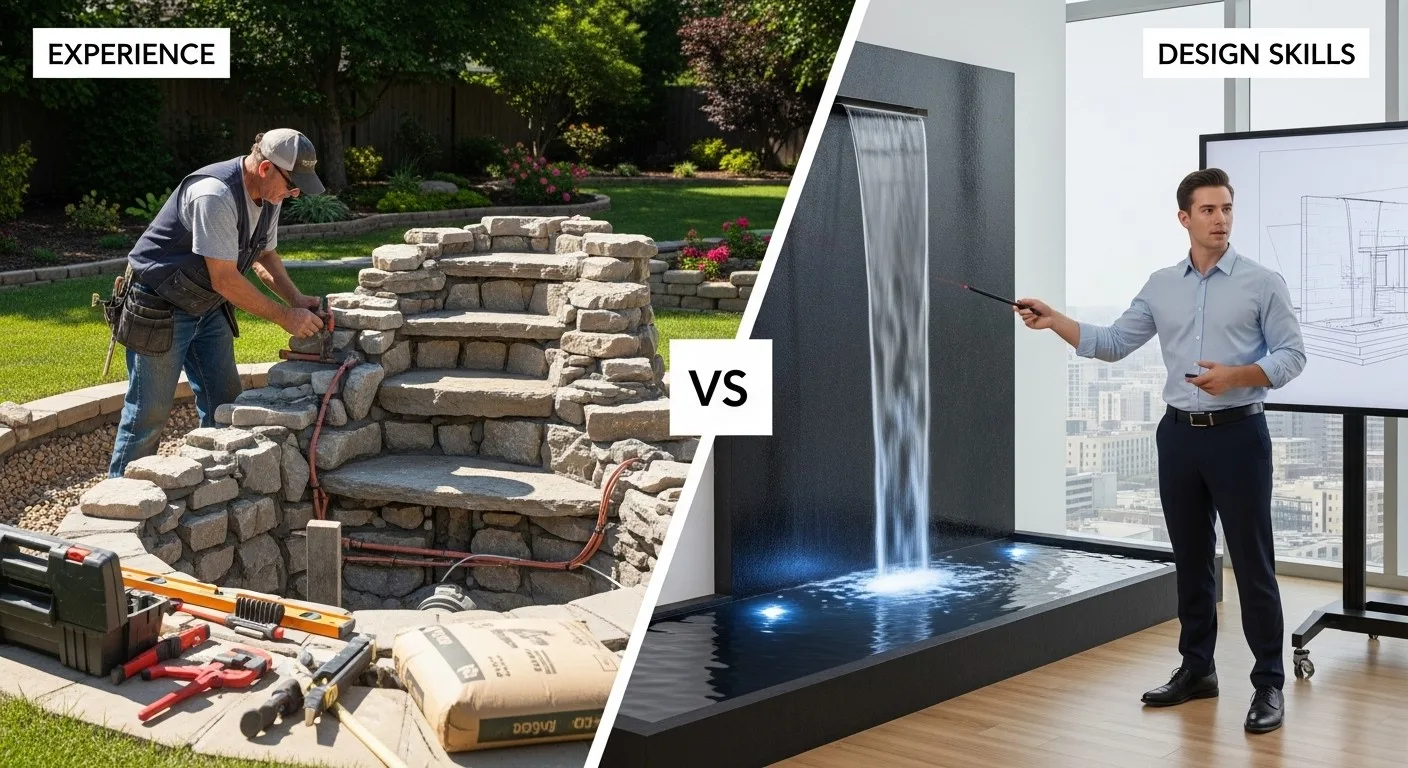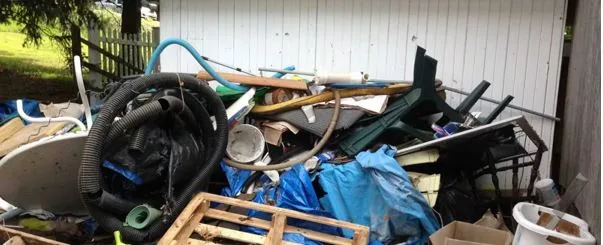What Makes a Good Water Feature Builder: Experience vs. Design Skills
Why the Right Builder Makes All the Difference
A skilled builder doesn’t just install a pond or fountain — they craft an experience that complements your outdoor space.
- Balancing Form and Function: Professional builders understand that beauty means little without performance. A pond that looks great on day one but leaks or turns green after a few weeks isn’t truly successful. The right contractor designs for water flow, filtration, and long-term maintenance while ensuring every rock and plant is positioned for visual harmony.
- Experience Alone Isn’t Enough: Years of hands-on work matter — but experience without creativity can lead to outdated or cookie-cutter designs. Skilled builders stay current with modern Aquascape trends and naturalistic design techniques to create features that enhance your home’s landscape rather than overwhelm it.
- Craftsmanship and Reliability: The best water feature builders take pride in the details — from compacting the soil properly to hiding plumbing lines and ensuring pumps are easy to service. Their craftsmanship ensures your investment stands up to Virginia’s seasonal changes, from humid summers to cold winters.
The Role of Experience in Water Feature Construction
Years of hands-on experience help builders anticipate challenges before they happen. Seasoned professionals understand that every property in Virginia — from the rolling hills of Powhatan to the clay-heavy soils around Chesterfield — presents unique challenges that affect design and durability.
- Understanding Soil Types, Slopes, and Drainage Patterns:
Experienced builders know that a water feature’s foundation determines its long-term success. They evaluate the terrain to ensure proper grading and water flow, preventing issues like erosion or flooding during Virginia’s rainy seasons. - Knowing How Different Materials Perform Over Time:
From flexible pond liners to natural stones and energy-efficient pumps, a builder’s experience helps them choose materials that hold up under Virginia’s temperature swings and humidity. They understand how UV exposure, soil pressure, and mineral-rich water can impact equipment and surfaces over the years. - Recognizing Common Installation Mistakes Made by Beginners:
Inexperienced installers may overlook essential details — like compacting soil properly, securing liner edges, or calculating the correct pump capacity. Skilled professionals, on the other hand, have learned through years of practice how to avoid these pitfalls and build features that last. - Ensuring Structural Integrity and Preventing Leaks:
A well-built pond or waterfall should run efficiently for years without constant repairs. Experienced builders use tested techniques for sealing liners, positioning rocks, and managing water levels to minimize leaks and ensure the system operates smoothly in every season.
The Importance of Design Skills and Aesthetic Vision
While experience builds skill, design brings creativity and flow to the project. A water feature should be more than a functional system — it should tell a story that complements the natural landscape and the homeowner’s lifestyle. Builders with strong design vision understand how to shape water, light, and texture into a cohesive, inviting outdoor retreat that feels alive and timeless.
- Using Texture, Elevation, and Lighting to Enhance Beauty:
Skilled designers know how to play with depth, layers, and illumination. They might use rough boulders for a rustic, natural effect or smooth stones for a modern finish. By incorporating gentle slopes, cascading levels, and subtle LED lighting, they create a sense of movement and visual intrigue that transforms a backyard after dark. - Creating Features That Look Natural, Not Artificial:
True artistry lies in making man-made features blend seamlessly with their surroundings. The best builders study how water behaves in nature — how it flows over rocks, pools in calm areas, and reflects light. They replicate these organic patterns, ensuring every line and contour feels authentic rather than forced. - Incorporating Elements for Harmony and Balance:
The placement of rocks, aquatic plants, and waterfalls isn’t random. Aesthetic design requires an understanding of proportion and flow. A well-designed pond integrates plant life to soften edges, rock groupings for structure, and cascading water to create a soothing soundtrack that enhances relaxation. - Balancing Sound, Movement, and Visibility:
Every water feature has a personality — from the quiet trickle of a small fountain to the dynamic rush of a multi-tiered waterfall. Designers think about how these elements interact with the homeowner’s environment. For instance, in suburban Richmond neighborhoods, a tranquil water sound can mask traffic noise and create a peaceful
Experience vs. Design: Why You Need Both
True mastery lies where technical knowledge meets artistic design. A stunning water feature isn’t just the result of solid construction or beautiful ideas alone — it’s the harmony between the two. The most successful projects come from builders who combine hands-on experience with a deep sense of creativity, ensuring that your pond, waterfall, or stream performs flawlessly while looking naturally breathtaking.
- Experienced Builders Prevent Structural Issues; Designers Ensure Visual Appeal:
A technically skilled builder knows how to construct a leak-free pond with proper filtration, stable rock placement, and efficient water circulation. However, without design expertise, the final result may look stiff or uninspired. On the other hand, a designer might create an elegant concept but lack the practical know-how to make it last through Virginia’s freeze-thaw cycles. The perfect outcome comes from combining both — durability and beauty in equal measure. - Collaboration Between Design and Build Teams Leads to Perfection:
Many of Virginia’s best water feature companies operate as “design-build” teams. This means the creative designer and the construction crew work hand-in-hand from concept to completion. This collaboration ensures that the artistic vision is achievable within the physical constraints of the site and that technical adjustments are made without compromising aesthetics. - Case Example: Function vs. Character:
Imagine two backyard ponds. The first holds water well, the pumps run efficiently, and there are no leaks — but it looks plain and artificial, like a bowl of rocks. The second pond not only runs smoothly but also captures the feel of a natural stream — with varied rock textures, lush aquatic plants, and a soft waterfall sound. The difference lies in design vision supported by construction expertise. - Why “Design-Build” Firms Offer the Best of Both Worlds:
Choosing a design-build firm ensures you’re not caught between competing priorities. These professionals handle everything from excavation to final planting, with one unified approach. The result is a cohesive water feature that’s structurally sound, visually stunning, and built to thrive in Virginia’s changing climate.
Warning Signs of an Amateur Builder
Not all contractors who claim to build ponds or fountains are experts. A poorly built water feature can lead to endless maintenance issues, wasted money, and disappointment — problems that could have been avoided by hiring a qualified professional. Knowing the red flags of an inexperienced or unqualified builder can help you protect your investment and ensure your project is done right the first time.
- Overlooking Filtration or Pump Sizing:
One of the most common mistakes amateur builders make is failing to properly size or install the filtration and pump system. If the pump is too weak, water circulation suffers, leading to murky water and algae buildup. If it’s too powerful, the water flow can be noisy, turbulent, and waste energy. Experienced professionals in Virginia calculate the correct flow rate based on pond volume, elevation changes, and desired water effects to achieve balance and efficiency. - Poor Rock Placement or Unnatural Water Flow:
Amateur builders often stack rocks randomly, without understanding how weight distribution and water direction affect appearance and function. The result is an artificial-looking pond with awkward water flow or visible liner edges. Skilled builders know how to blend different rock sizes, create natural cascades, and position stones so the feature looks as though it formed naturally in your landscape. - Lack of Portfolio or References:
A professional water feature builder should have a proven track record. If a contractor can’t provide photos of completed projects or customer testimonials — especially from Virginia homeowners — that’s a major red flag. Reliable companies proudly showcase their past work and can connect you with satisfied clients who confirm the quality and longevity of their installations. - Unclear Contracts or Unrealistic Pricing:
If the proposal seems too good to be true, it probably is. Amateurs may offer unusually low prices but cut corners with cheap materials, improper liners, or inadequate installation practices. A reputable builder will provide a transparent, itemized contract that outlines materials, labor, warranty terms, and project timelines — ensuring no surprises along the way.
How to Evaluate a Water Feature Builder Before Hiring
Choosing the right builder starts with asking the right questions. The decision you make will determine not only how your pond or waterfall looks but also how well it performs and how much maintenance it will need in the years ahead. Before signing any contract, take the time to do your research and evaluate each builder’s credibility, expertise, and professionalism.
- Review Past Work and Customer Testimonials:
A reputable builder should proudly showcase their previous projects — ideally through an online portfolio or photo gallery. Look for examples of features similar to what you want, whether it’s a koi pond, a cascading waterfall, or a pondless design. Reviews on Google, Facebook, or local Richmond platforms can also reveal patterns of satisfaction (or warning signs). Pay attention to comments about timeliness, communication, and long-term performance of the installations. - Ask About Certifications or Training:
Professional training demonstrates a builder’s commitment to quality. Certifications such as Certified Aquascape Contractor (CAC) status show that a builder has completed specialized courses in design, installation, and ecosystem pond maintenance. Builders with ongoing education stay current with best practices and new technologies — ensuring your water feature is both efficient and environmentally friendly. - Discuss Warranty Terms and Maintenance Options:
A confident builder stands behind their work. Ask what kind of warranty covers the pump, liner, and installation. Some companies also offer maintenance packages that include seasonal cleanings and system checkups, which are particularly valuable for Virginia homeowners dealing with leaf debris and winter freezes. Clear warranty and service options show that the builder plans for long-term success, not just a one-time installation. - Examine the Proposal’s Detail and Clarity:
A well-prepared, itemized proposal speaks volumes about professionalism. Look for clear descriptions of materials, equipment, project phases, and estimated timelines. Vague quotes or verbal promises can lead to misunderstandings and extra costs. The most trustworthy builders take the time to outline every detail, ensuring you understand exactly what’s included and what to expect from start to finish.
The Perfect Combination: Technical Precision and Creative Passion
The best builders treat every project as both an engineering challenge and a work of art. They understand that a successful water feature isn’t achieved by chance — it’s the result of careful planning, technical expertise, and a genuine passion for design. Whether creating a small backyard fountain or a large koi pond in Richmond, true professionals merge science and creativity to deliver exceptional, lasting results.
- Using Modern Technology for Smarter Designs:
Today’s top water feature builders embrace innovation. They use 3D design tools to help homeowners visualize their project before construction begins, allowing adjustments to layout, scale, and elevation. Advanced filtration systems, energy-efficient pumps, and eco-friendly circulation setups ensure optimal performance while conserving water and electricity — an important consideration for Virginia’s variable weather conditions. - Combining Artistic Rockwork with Functional Filtration:
Crafting a natural-looking water feature requires both artistry and engineering. Expert builders know how to layer stones for structural stability while concealing plumbing and filtration components seamlessly. The result is a pond or waterfall that looks effortless but functions flawlessly, maintaining water clarity, proper flow, and aesthetic appeal. - Focusing on Long-Term Enjoyment, Not Installation Speed:
Amateurs may rush to complete a project, but experienced professionals understand that quality takes time. They prioritize precision over speed — from compacting the soil base to testing pumps and fine-tuning water flow. Their goal isn’t just to finish the job but to create a relaxing, low-maintenance retreat that enhances your outdoor living experience year after year.
Balance Is the Key to a Lasting Water Feature
A great water feature builder is part engineer, part artist. Experience ensures that your pond, waterfall, or fountain is structurally sound, leak-free, and easy to maintain — while design skill adds the “wow factor” that makes it a true focal point of your landscape. When both qualities come together, the result is a water feature that enhances your property’s value, brings peace to your outdoor space, and continues to perform beautifully year after year.
Virginia homeowners deserve more than just functionality — they deserve craftsmanship that blends technical precision with natural artistry. The best builders understand how to work with the land, adapt to local weather patterns, and create features that feel timeless and alive.





